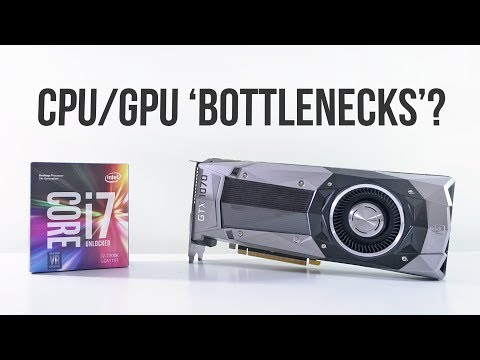This makes it harder for builders who want to benchmark CPU’s performances /and gamers with a limited budget. Especially those who might have an excellent Quad-Core CPU or stuck with a relatively weak GPU. But not all hopes are gone. We’ve compiled a list of CPU intensive games to check the processing power of your next gaming PC or even gaming Laptop. These CPU intensive games require no more than a few Gigs VRAM to run. Lowering down the graphical settings might help sustain more significant FPS and smoother gameplay. For the low-powered processor latest games might be too harsh. But rest assured, you won’t suffer from frame loss or unable framerates on most of the games.
GPU Bottleneck
A bottleneck, in general, is when the capability of both provider and consumer varies. In this case, if your CPU is more powerful than your GPU, it’ll provide more data than the GPU can handle. This results in your CPU being idle which in terms is called GPU bottleneck. Rather than focusing on the graphics, CPU does the logic labor. The mechanics and AI of any non-playable character require CPU’s effort to even exist. Most of the latest games running in 1080p depend on the CPU, but the CPU resources are limited after pushing games over 1440p resolution. Gaming in 4K pushes your GPU more than your CPU. So, you can take GPU as your painter friend who sees the world as a blank canvas while CPU, that nerdy friend without whom the canvas can’t even exist. But, at the end of the day, the requirement of both depends on what type of game you choose to play. Similarly, if you pair a powerful GPU with an adequate CPU, this causes idle GPU which is called CPU bottleneck. Even though the hardware is the major factor, the task or the games you select can cause a significant impact on the hardware. Today, we’ll see CPU intensive games to deal with the GPU bottleneck.
Civilization 6
Sid Meier’s Civilization 6 is a beautiful 4x strategy game. The sole purpose of this game is to grow your civilization and stomp other civilizations on your way. The game drastically forces players to upgrade your civilization using technology, fighting for resources, destroying other cities. Indulge yourself in the history of the pre-existing great civilization. Battling your way through great civilization and asserting dominance is excellent. But as the game progresses, it becomes taxing on your CPU more and more. The game does look more comfortable to run thanks to its gameplay, visuals, and mechanics. But as you progress through the level and want more difficulty, that’s when your CPU revs up. Think of it like chess. Every move should be precise and demands constant thinking for the User and the AI. Not only that, as the maps grow bigger and bigger, the game already taxes tons of load on the CPU. Adding the AI computing strength adds more load to the already massive map game. GPU: 1 GB Direct X 11 (AMD 5570 or Nvidia 450)RAM: 4 GB RAM Storage: 12 GB or more Genre: 4X Strategy Developer: Firaxis Games The AI on the game solely depends on your processor. The AI is continuously running in the background to keep the fun going. Plus, it uses more CPU horsepower to compute its decision and calculate the outcome of each move. Sometimes the AI takes as long as 10 minutes to finalize its move. Now that is going to be a tough match for professionals and hardcore Civilization fans. This isn’t great for lower-end CPUs, but the mid-tier or budget Quad Core CPU can handle the challenging load that the game offers.
Assassin’s Creed Origin
The Assassin’s Creed franchise is the best RPG game in the market and still is one of Ubisoft’s top-selling games. But the Assassin’s Creed Origin was the most infamous title among all the game series. Assassin’s Creed Origin is set in ancient Egypt near the Pyramid of Giza, surrounded by famous entities like Cleopatra. The game’s visual is stunning with an added flair Assassin’s franchise flair to the Ptolemic era. Roam around the scenic beauty of ancient Egypt, roaming desserts and lakes while struggling to survive in a cruel monarch with your family.
Minimum Condition:
The Assassin’s Creed Role-playing theme is excellent, but it does hit a lot on the CPU. The early release of the game caused crashes in major Quad-core processors. Let’s say it was unoptimized at first. But even after fewer patches and fixes, it still does put a lot of strain on the CPU. The game engine and the game physics make the CPU work hard. The complex computing of the physics is hard enough but adding another layer of the DRM system is a lot of pressure on the CPU. The Denuvo DRM software was quite infamous for its high CPU usage, making even higher-end CPUs sweat at the time. The game was unoptimized at first, causing the CPU to underperform, utilizing only 60% percent. But after the patch and the Denuvo DRM software, the games spiked in CPU usage, taxing the Core i7 8700K. Now things have finally settled, but Assassin’s Creed Origin still needs tons of CPU horsepower to run. The storyline and the visuals are stunning, but the engine hits heavy on the CPU while playing, so better overclock your processor or get a higher newer generation CPU. Because if you are a fan of the AC franchise and RPG games, this game should not be missed by anyone. If you lag in-game, might suggest dialing back some settings to achieve playable or more FPS.
Crysis 3
Can your system run Crysis? Yes, This question went as a meme in the community or asking if your new gaming computer could handle this challenging game. The Crysis franchise, mostly Crysis 1, was ahead of its time. The Crysis 1 had great graphics and a game engine way forward, and its hardware didn’t fully support it. But the latest Crysis 3, even though being old, still does sweat out the mid-range to high-end PC.
Minimum Requirement:
The Crysis game is based on the post-apocalyptic world where you, as a soldier, survive the aftermath of both Crysis 1 and Crysis 2. The player is trying to fix the big alien problem and alien invasion over the Earth. The First Person shooter based game is vivid and features tons of gameplay mechanics to learn. The suit mechanism is excellent for combat and stealth operation, whereas the shooting and aiming mechanism are refined very well. But you might ask why this old game still causes mid-range and high-end games to sweat a lot. GPU: 1 GB VRAM DirectX 11 (Nvidia GTS 450 or AMD Radeon HD5770) RAM: 3 GB Storage: 17 GB or More Genre: First-person Shooter Developer: Crytek (EA) The Cryengine – the game’s engine is quite heavy and sucks in a lot of resources. Plus, the game physics is almost lifelike, so calculating taxes on the CPU itself. Bullet drop distance, fall velocity, NPC AI, and the enemy AI push the CPUs to its limit. If you don’t have a suitable processor for the game, you might be struggling with the game, and facing some frame drops on in all. The Crysis 1 just got a remastered version, and it does suck tons of CPU power like the older version. But the GPU is getting the most hit with the addition of Ray-Tracing and visual improvement.
Grand Theft Auto V
If you love the open-world thrill in games, you will surely love Grand Theft Auto V. Grand Theft Auto V, an open-world game developed by Rockstar. It has been seven years since it’s launch but draws tons of players thanks to its game update and added DLC content. GTA is a roleplaying game that has grabbed the attention of tons of people. You should have a good enough system to run the game at max settings with good FPS. Plus, open-world games do present a system with a vast world to be rendered.
Minimum Requirement:
The open-world concept games are a great hit in the gaming community, especially GTA V. The open-world design of the game is already a performance leecher. The AI controls every NPC, and each resource of the vast map is loaded beforehand. The CPU decompresses and compresses the data needing to do a lot of work, so looking at the extensive map has much data. Going online asks for more resources meaning more processing power. GPU: 1 GB DirectX 11 (Nvidia 9800GT or AMD HD 4870) RAM: 4 GB Storage: 100 GB or More Genre: Open World / Role Playing Developer: Rockstar Games GTA V is a fantastic open-world video game, but the fun adds more when adding mods to the game. The mod opens up tons of opportunities in the game. Adding Tony Stark’s Iron Man suit, rampaging the streets of Los Santos, or even updating the graphics obtained near realism. There are endless modding in this game. But the adding mod to the games invites the adds more on the table for the CPU. The mod adds more processing tasks on the CPU’s hands, increasing the burden already imposed by the open-world environment. So if you look to add many mods, upgrade the CPU to something better or even overclock the CPU.
Shadow of the Tomb Raider
Square Enix creates some of the best Triple-A titles in the market. The Tomb Raider is one of the famous franchises created by Square Enix. Rise of the Tomb Raider was already a masterpiece from its visual to the mechanics. Still, the Shadow of The Tomb Raider beats every expectation and summits itself as the best Triple-A title on the market.
Minimum Requirement:
The Shadow of The Tomb Raider is an action-based RPG game where you play as the protagonist, Lara Croft, exploring the beautiful open world’s ruins and caves. Square Enix tried to beat the previous title. But as for processing power goes, you will need a better PC to run it at 144Hz or even higher. If you see fit for 60fps gameplay, then the Quad Core’s processing power is enough. The game’s open-world environment taxes a lot of strain on the CPU decompressing the whole world and taking care of the NPC around the map. The visual is stunning as usual, but still, the mechanics and physics aren’t that heavy for the higher-end CPU but still beats the hell out of the upcoming Quad Core processors. GPU: 2 GB DirectX 11 ( Nvidia GTX 660 / AMD Radeon HD 7770) RAM: 8 GB Storage: 40 GB or More Genre: Action-Adventure Game Developer: Eidos-Montreal The Shadow Of The Tomb Raider utilizes the power of the multiple cores. The multi-core processing removes the stress from the single-core performance. Focusing on the CPU’s overall performance allows the task on hand to be divided among multiple cores. Most of the game engine depends on the single-core for the heavy lifting whereas the foundation engine from Square Enix utilizes the most out of multi-core system including six cores to the 12 cores processors.
Far Cry 5
Ubisoft has tons of Triple-A games, and Far Cry 5 is a great title. The Far Cry franchise has been a staple in Ubisoft fans, and it delivers as per its name. The predecessor to the Far Cry New Dawn, both run on the same Dunia engine. The game takes you to Hope County, Montana, where you have to fight your way through. A preacher takes over Hope County, and you have to save the people and redeem yourself.
Minimum Requirement:
The title has similar open-world gameplay from the franchise. The first person shooter is a great staple for anyone looking for adventure. The Dunia Engine is a refined game engine, but it does use quite a bit of CPU resources. The engine utilizes more cores offering more performance but solely depends on the single-core performance of the CPU. Plus, it is an open-world game. It will push the CPU to its limit with its AI. The NPC and the game physics do take a toll on the system. Each geometry calculation and physics simulation on the game engine does take a lot of CPU resources. GPU: 2 GB VRAM ( Nvidia GeForce GTX 670 or AMD R9 270) RAM: 8 GB Storage: 40 GB or More Genre: First Person Shooter / Action-Adventure Game Developer: Ubisoft Montreal; Ubisoft Toronto There is no DRM system like on the Assassin’s Creed Origin. It takes fewer resources compared to Origins. But whenever you are retaking outposts, make sure you have tons of processing power on hand. The outposts have tons of opponents, meaning the use of AI and drawing in more CPU power. If you want to test your CPU limit, please use the benchmark tool inside the settings. Pre-checking your setting will ensure better optimization of the graphics and the game according to your system specification.
Red Dead Redemption 2
If the wild west is your thing, then you will love the Red Dead Redemption 2. The sequel to the console exclusive Red Dead Redemption. The RDR2 is an action-adventure game played in both first and third-person perspectives. It has an open-world style game design with extensive flora and fauna. The open-world can be experienced online or in single-player campaign mode combating with enemies via close combat, firearms, and many explosives.
Minimum Requirement:
Red Dead Redemption 2’s world is massive and demands more on the CPU, aside from its graphics. The previous title was only available in the console, making it hard to compare. But the open-world environment, tons of NPC and enemy AI does take a lot of CPU power. Sometimes the game is kind of wonky on the game physics aspect. Still, it is a great title needing a lot of power to run it. The demanding title does require a great CPU like the Core i5 9th generation or even higher-end Ryzen 7 3800X. Red Dead Redemption is excellent considering that you have a powerful CPU with 6 – 8 cores and an excellent GPU to back the performance. GPU: 2 GB DirectX 11 (Nvidia GeForce GTX 770 or AMD Radeon R9 280) RAM: 8 GB Storage: 150 GB Genre: Action – Adventure Game Developer: Rockstar Games
Counter-Strike Global Offensive
This title is not for the higher-end system like the Ryzen 9 3900X or even the Intel Core i9 processor. It is an excellent test for the lower-end CPU and mid-ranged CPU. Counter-Strike Global Offensive is a first-person shooter game developed by Valve. The title has a simple objective and is understandable to even the newest person. The title uses Valve’s old Source engine, which is quite old and needs a revamp to the upcoming Valve Source engine 2.
Minimum Requirement:
Counter-Strike Global Offensive is the main staple in the Esports community. The tactical based shooter divides ten people into two teams. The objective is simple: the terrorists have to plant the bomb and defend it, whereas the counter-terrorist defuses the bomb or prevents it from being planted. The game is easy to learn, and it features a lot of weapons according to the player’s liking. The difficulty is added, introducing the throwables and round economy. GPU: 256 MB or Higher RAM: 2 GB Storage: 15 GB or More Genre: First Person Shooter Developer: Valve; Hidden Path Entertainment The Source engine is quite old but still works like a charm. Counter-Strike Global Offensive doesn’t have an FPS cap. The FPS can be capped in-game but releasing the Cap allows the CPU to push its frames further. For the higher-end CPU, it is no problem but benchmarking the lower-end CPU and budget CPU fit the game. Since it doesn’t need a GPU, everything relies on the CPU, from the game mechanics to the bullet tracing and hitbox detection. So if you have an old Dual-Core or even older AMD processor lying in the back and want to test it out, Counter-Strike is a great test game for older and lower-end processors.
Total Warhammer 2
Total Warhammer 2 is the long-lasting title in front of the Total War series. Released in 2016, the game is a turn-based strategy game as you conquer the world with your army and empire. Manage your empire and resources while taking a look at your troops rallying to dominate the world. Based on the Warhammer universe, you try to manage your army, ration them, and fight against your enemies.
Minimum Requirement:
The turn-based system taxes a lot of CPU power on a higher difficulty level. The AI’s calculation and engine draw a lot of processing power. The player standpoint might be easy to handle, but the game engine and graphics design attract a lot of processing power. The graphics on the game is mostly not that great solely; the performance lingers around the CPU. So when it comes to Total Warhammer 2, you will need a minimum Quad-Core processor to run it on a 1080p medium with a more significant FPS gain. GPU: 1 GB DirectX 10 ( Nvidia GeForce GTX 460 or AMD Radeon HD 5770) RAM: 5 GB Storage: 60 GB or More Genre: Real-Time Tactics Developer: Creative Assembly It is a turn-based strategy game, so the CPU does eat a lot of the processing power. The game’s AI takes a lot of time, even over 5 minutes, to make its move. However, Total Warhammer 2 is excellent on its own, and we recommend turning down the settings for more FPS games.
Rainbow Six Siege
Rainbow Six Siege is an exciting approach to the FPS genre. The shooter game fills up the similar action brought by the Counter-Strike and elevates it. The operator based action shooter takes a twist on the FPS genre and adds tons of destructible environment. Yes, most of the things you see in the game are destructible, allowing more areas to breach and regions. And not only that, you will have tons of ways to defend your position as well.
Minimum Requirement:
The Rainbow Six Siege might look like your average FPS games. But it does draw a lot of CPU resources. Graphically wise, the game might look decent, but the CPU does a lot of work running the game engine. The bullet traces, hitboxes, destructible environment, character gadgets, etc. utilize many CPU resources. Rainbow Six Siege hits most on the single-core and its boost clock. So you will need a tremendous single-core performance CPU to run it well. Consider Intel if you are reaching out to play Rainbow Six Siege. It has a higher single-core clock and single-core performance. We advise the latest Core i3 9th gen or the higher end i5 processor the game. GPU: 1 GB DirectX 11 ( Nvidia GeForce GTX 460 or AMD Radeon HD 5770) RAM: 6 GB Storage: 61 GB or More Genre: First-Person / Tactical Shooter Developer: Ubisoft Montreal It is quite amazing to see an easily runnable game taxing on the single-core performance. Rainbow Six Siege is one of the best competitive FPS games on the market. It has excellent physics, a destructible environment, and is incredible to watch ragdoll physics.
Minecraft
Survival game mode meets the sandbox world, Minecraft is a masterpiece for its own. The game is very simplistic. All you have to do is survive the night and defeat the zombies as you grind your way to the end. The cartoonish graphics and square environment might throw you off, but there is tons of space to create and innovate in-game. Your imagination is limitless on what you make or create. Mine inside a cave obtaining valuable ores and mine shaft and dungeons. Or enter creative mode and build your own house or mechanics.
Minimum Requirement:
The game might look childish, but it does affect your CPU usage. The physics on Minecraft is excellent, but when rendering tons of chunks. The environment needs a lot of CPU resources to load. Plus, when you add a complicated red-stone contraption or spawn tons of entities in the world, you will chug tons of system memory and CPU process. As simple, it might be, it does draw a lot of power. And if you think your CPU is quite a fancy, try blowing up a mountain with tons of TNT; that will strain your CPU a lot. Seriously it draws a ton of power from the CPU when blowing up a mountain of TNT. GPU: 1 GB DirectX 9 ( Nvidia GeForce GTX 460 or AMD Radeon HD 5770) RAM: 4 GB Storage: 1 GB or More Genre: Sandbox / Survival Developer: Mojang Studios The creativity of this sandbox game is endless, with automatic farms, launchpads, and even mods. The Mods are relatively simple but do take more CPU usage. Mods have different unique physical lines of codes and display different characters aside from the in-game entities. If you think you have the top of a line PC, this game might bring it down to Earth with its mods and CPU usage.
Cities: Skylines
Perfectionist and smart developers have welcomed to the game of Cities: Skylines. It is a management simulation game as you grow a colossal city from the ground up. Cities: Skylines gives you a plot of land where you have to grow your city and manage the overall population. Adding rails increases buildings, infrastructures, etc. You are creating the city that you truly are and test your management skills while growing the city.
Minimum Requirement:
The game is simplistic enough, the graphics aren’t that great, but the gaming experience and skills are developed. As your city grows, more and more stuff is being added to the game. More population leads to more traffic, more facilities, etc. The CPU starts to strain as more and more entities are added to the game. The AI does draw a lot of CPU power when simulating the weather, traffic, and rendering the overall game. As you expand more land, more CPU resources are taken up, and you are stuck with a slow responsive city. GPU: 512 MB DirectX 9 ( Nvidia GeForce GTX 260 or AMD Radeon HD 5670) RAM: 4 GB Storage: 4 GB or More Genre: Construction and Management Simulation Developer: Colossal Order The Cities: Skyline engine draws more CPU resources and benefits from more cores. More the cores fluid the gaming experience. A modern quad-core can handle this game very well with no stutter and real-time updates.
Diablo 3
Diablo 3 is an MMORPG with gameplay packed to the brim with flourish mechanics and multiplayer. The hack and slash aspect of Diablo 3 is met with an intrigued game design and looting system. You are playing the game as one of the five factions in-game with a narrow storyline. The story is mediocre, but once you get into dungeon raiding and multiplayer, you will love Diablo 3. Blizzard has refined and accumulated tons of newer features in Diablo 3, which will get you hooked by the minute. It makes the player come back for more time after time.
Minimum Requirement:
Diablo 3 doesn’ tax the GPU much. Everything in the game relies on the CPU itself. Even looking at the gameplay trailer, you might get a view about the visuals. But that is not the point for Diablo 3. The in-game engine draws a lot of resources, so does the NPC and the AIs. Each enemy has a specific skill set and skills that draw minimal CPU resources. But each dungeon spawns more and more enemies causing the CPU usage to skyrocket. Not only that, the dungeon has randomly generated loot and terrain. Each time you enter a dungeon, the interior or the enemies aren’t the same. So the randomness of the game does draw tons of resources allowing more variation when entering the same dungeon or boss raids. Overall, the game experience is excellent and requires Intel 4th generation Quad-Core CPU to harness the game’s beauty fully. GPU: 256 GB DirectX 9 ( Nvidia GeForce 7800GT or AMD Radeon X1950 Pro) RAM: 1 GB Storage: 12 GB or More Genre: Hack and Slash Developer: Blizzard Entertainment
CPU Intensive VS GPU Intensive
You already know about the CPU and bottlenecking. But what is the difference between CPU intensive games and GPU intensive games? The CPU drives the game engine. The game’s general physics and the AI is directly looked at by the CPU. The CPU handles the NPC, fall damage, bullet drop rate, etc. all. So the overall game depends on the CPU to run. The engine runs in the background as the CPU manages its whole task and calculates its what the engine tasks the CPU. GPU or the graphics processing unit is in charge of the visual of the game. The GPU renders everything you see in the game shadows, player model, environment all. The GPU rendered each polygon in the game, giving life to the model you see. The lighting, shadows, etc. both take a lot of processing power. Since the CPU already has too much on its plate, the rendering is left on the GPU to perform. The GPU renders polygon, lighting, and shadows; the generated information is then sent to the CPU, which decodes it for the users. CPU intensive games usually rely on the CPU to do the heavy lifting and manage the game engine. It needs only a decent to low powered GPU to run it. The Decent GPU does only slight work rendering the visuals. GPU intensive games rely on the visuals taxing more on the GPU. Modern games don’t use CPU much. The massive graphic games require top tier GPUs to run it. Each GPU processing work is done using float points; the higher the floating processing power, the better the GPU performance. In GPU intensive games, the CPU utilized a single or quad cores at max. So a mid-tier CPU paired with a good GPU is an excellent combination for GPU intensive games.
CPU Hierarchy
There are several CPUs in the market, and nowadays, the games have become more demanding. The dual-core processors were considered as the low-end CPU in the past. But as technology advances more and more, game engines have been pushing CPU to their limit. Previously game titles didn’t even utilize more than four cores, but titles like Red Dead Redemption started pushing Quad Core processors to their boundaries. Nowadays, the low-end gaming CPU mostly consists of Quad Cores and is shadowed by the six cores, eight cores, and 12 cores processors. So today, to understand CPU for gaming a little bit, we separated it into three categories.
Low-End/Entry Level
The low-end gaming processors are still in the mixed bag situation. If you are playing esports titles or older games, a dual-core Athlon or Core i3 processor is enough to game on it. Mind most newer Dual Core CPUs can efficiently run the games without any stress. The AMD Athlon 3000G and the Core i3 7th generation are great examples of the Dual-Core processors. But the Quad Core is now readily available in the market, and the Older Core i7 7700K is outcast with the newer Ryzen 3300X processors. The Ryzen 3300X is one of the latest Quad-Core processors from AMD, costing a ⅓ price of the Core i7 7700K MSRP. So talking about the latest games, the Quad-Core like the Core i3 9100 or the Ryzen 3300X are the entry-level processors, whereas the Athlon is dubbed as low-end gaming processors.
Mid-Range
The Mid-Range processors are overfilled with tons of options from AMD and Intel. The Intel Core i5 processor and the Ryzen 5 are fitting for the mid-range rulers. The mid-ranges especially start from 6 core processors. The latest Ryzen 5 3600 and the Intel Core i5 10600 will go head to head with their six cores and 12 threads. 6 Cores are a norm for streamers and gamers alike. Most of the games don’t even run in all six cores, so the reserved cores are used for multi-tasking or even streaming. But as more and more game developers focus on multi-core rendering and gaming performance, six cores will not be enough for gaming and streaming in a few years. Plus, there are some exceptions like the Ryzen 5 3500X, which has six cores and six threads. Intel also had removed SMT on the previous Core i5 9th generation CPUs. They still work great but have removed virtual cores reducing a tad bit of performance, not even noticeable while gaming.
High-End
The Higher-End processor features tons of CPU cores and processing power. It is an overkill for gaming, but the market offers various High-end processors like the Core i7, Core i9 to the Ryzen 7 and Ryzen 9. This is more than enough for gaming and can handle significant tasks thanks to more core count and better clock speed. The higher-end processor compromise of 8 cores and above. The Intel Core i7 10th gen processor features eight cores and 16 threads, whereas the Core i9 10th gen features ten cores and 20 cores. Now that is overkill for gaming, but it is a lifesaver if you’re streaming off the same computer. The more cores offer more processing power and multi-tasking capabilities. If you own a Ryzen 9 3950X, you can even game while simultaneously opening tons of google chrome tabs for rendering a video in premiere pro. That is what a high-end CPU can run, and throwing games at 1080p or 1440p will be a joke to them. But as always, the CPU doesn’t have a system power. You will still need to pair it with a suitable or powerful GPU. So there were the CPU intensive games on your list. What have we missed, and what did you think about the list? Please comment down below as we try to update you on tech and hardware news around the clock.













